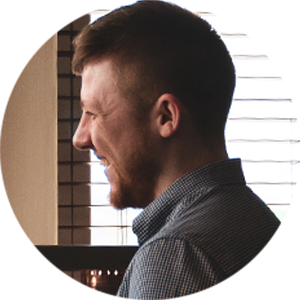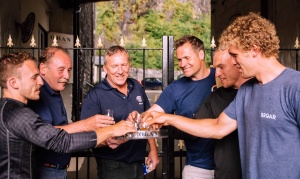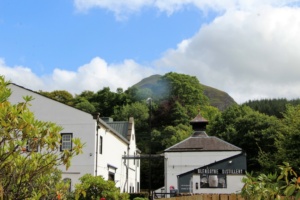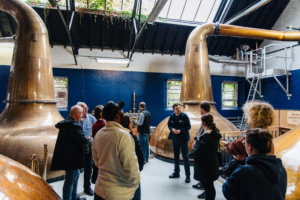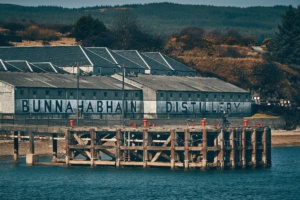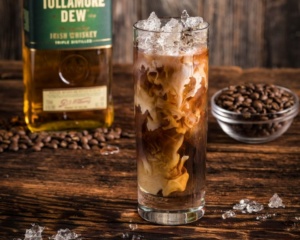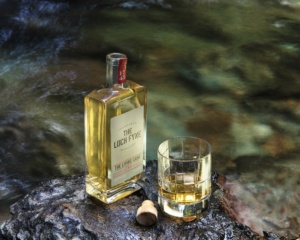Kingsbarns Distillery: From Dream To Reality
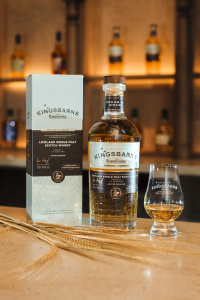
Once the least regarded of all official Scotch malt whisky production regions, the Lowland category has come back with a spectacular bang. Not so many years ago, there were just two operational malt distilleries in the Lowlands but that number now stands at 14, with several more in the pipeline.
‘Lowland’ embraces the area south of a line drawn between the Firth of Clyde in the west and the Firth of Tay in the east. It encompasses the county of Fife, where Kingsbarns distillery has been established in a formerly semi-derelict-farm steading, located in the picturesque ‘Easy Neuk’ area, between the university town of St Andrews and the fishing village of Crail.
Kingsbarns and Wemyss
The man who must be credited with having the vision and persistence to create Kingsbarns is Doug Clement, a professional caddy at Kingsbarns Golf Links and a whisky lover, who began to plan the project in 2009. 2012 saw his determination pay off with the award of a £670,000 grant from the Scottish Government, after which the Wemyss family, led by brother and sister William and Isabella, bought into the venture, officially taking control in January 2013.
The Wemyss family can trace its roots in Fife back to the 14th century, and during the 18th century it was one of the leading coal mining owners in the county, at one point shipping 6,000 tons of coal per year to the Netherlands, and helping to fuel the industrial revolution.
Wemyss connections to the Scotch whisky industry date back to 1824, when John Haig built a distillery – now Diageo’s vast Cameronbridge grain distillery – on land belonging to the family, close to its ancestral home of Wemyss Castle.
After the Second World War, the Wemyss’ family entered the wine industry, now owning the wine estate of Rimauresq Cru Classé in Côtes de Provence, and in 2005 William Wemyss set up the independent bottling company of Wemyss Malts, specialising in creating and retailing blended malts.
From the outset, the firm used descriptors as names for its whiskies, hence the core range now consisting of The Spice King, The Hive, and Peat Chimney. Additionally, batches of single cask bottlings are released from time to time.
Having established Wemyss Malts, owning a distillery seemed the next logical step, and with nothing suitable on the market, it was logical to link up with Doug Clement and an existing project, particularly as it was based in Fife.
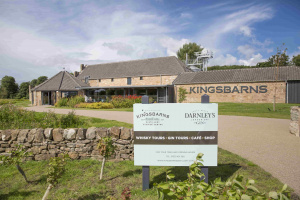
Creating Kingsbarns
The buildings destined for distillery development carried B-listed status and had been built in around 1800 as part of East Newhall Farm at the behest of Thomas Erskine, 9th Earl of Kellie, owner of neighbouring Cambo House.
One of the most striking architectural features of the steading is its doocot – or dovecot – which has the appearance of a fortified tower. Within it were 600 terracotta nesting boxes for the resident pigeons, which provided eggs and meat for the Cambo estate.
Restoration of the historic buildings and the creation of a new distilling production area began in June 2013, and lasted for three years, costing in excess of £3 million. According to a Wemyss spokesperson, “The doocot remains the iconic centrepiece of the former farm steading and a symbol for our whisky. It evokes our roots and heritage, and within its walls we celebrate the future of Kingsbarns distillery by displaying the first cask to be filled with our spirit.”
The distillery officially opened on St Andrew’s Day 2014, and that first cask was filled in March of the following year. The man tasked with leading the project from its infancy is Glasgow-born distillery manager Peter Holroyd. He is a graduate of Heriot Watt University in Edinburgh, where he studied brewing and distilling, working in the brewing industry before landing the coveted post at Kingsbarns.
Making Single Malt
In terms of the distilling set-up and how it produces the desired style of spirit, Holroyd explains that “We have a semi-lauter mashtun, made by Musk, a firm more usually associated with the brewing industry. We aim to produce clear wort in the mash tun, as this gives estery spirit, with lots of fruit character, which is what we are looking for.”
Fermentation takes place in four stainless steel vessels, and Holroyd emphasises that “We have three to five-day fermentations, which is quite long, and helps produce the fragrant, estery style we’re targeting. We use 50/50 two types of dried yeast, namely, Anchor, which has been in use for decades, and Fermentis, which is Belgian, and gives us our top fruity notes, especially pear drops, orchard fruits, and even red berry aromas.”
Kingsbarns is equipped with one pair of stills made by the renowned Forsyth of Rothes, on Speyside. “Our stills are lamp-glass style, and we would have liked them to be taller,” says Holroyd, “but it’s a listed building, so we could only go to a certain height. The lyne arms are relatively level and very long. We run the stills extremely slowly, and we give them a break between distillations to let the copper rejuvenate. All of this this helps to deliver a ‘clean’ spirit.”
He adds that “We take a high cut and a fine cut in the spirit still, targeting lighter congeners. We run eight minutes of ‘heads,’ then collect the ‘heart of the run’ – between 75% and 69%abv – then we go on to ‘tails,’ so it’s a fine, narrow middle cut. We end up with a complex and balanced new-make spirit, and we can produce 34 barrels per week, or up to 200,000 litres of spirit per year.”
Some 80 to 85 per cent of Kingsbarns new-make spirit is filled into first-fill ex-Bourbon casks, all of which are sourced from Heaven Hill distillery in Kentucky to maintain consistency. Additionally, a small number of sherry butts and port pipes are filled, and Peter Holroyd adds that “We also use shaved, toasted and re-charred 225-litres casks from Portugal that previously held red wine. They give quite a plummy, herbal, rich and slightly drying character to the spirit.”
Due to constraints of space, most of Kingsbarns new-make spirit is transported by road tanker to Inchdairnie distillery at Glenrothes, just over 20 miles from Kingsbarns, where it is filled to cask and stored. This allows Wemyss to boast that not only is the whisky distilled in Fife from locally-grown barley, but it is also matured in the county.
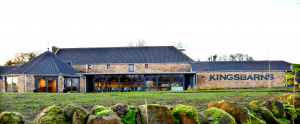
Dream to Dram
So, what about that whisky? In January of this year, the first bottling to be released to the general public was launched under the name ‘Dream to Dram,’ and met with instant success. It followed a limited release of ‘Founders Reserve’ for members of the Kingsbarns Distillery Founders Club, bottled the previous month.
Peter Holroyd says that “Dream to Dram is our house style. It comprises 90 per cent spirit matured in Bourbon casks and 10 per cent from Portuguese red wine casks. Our aim was to get an established style and make it accessible to consumers in terms of price. We use local barley which is quite costly, and running stills slowly uses more energy, so making Kingsbarns single malt is quite expensive. All of it is reserved for single malt bottlings. The quality of the whisky speaks for itself. It’s light and fruity, and therefore fast-maturing.”
The launch of ‘Dream to Dram’ was followed by two cask strength single cask bottlings, matured only in first-fill Bourbon barrels, one of which is exclusively available at the distillery shop, while the other sold its entire outturn of 204 bottles online within 72 hours of being released. More single casks bottlings will follow, but they will be limited in number.
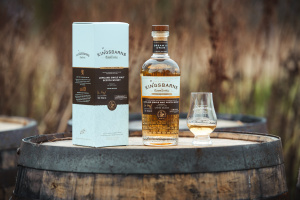
Gin and Lowlands
For those with a fondness for white spirits, Kingsbarns is also now home to Darnley’s Gin, made in a separate building adjacent to Kingsbarns production facilities. As Peter Holroyd explains, “Darnley’s Gin was previously distilled for Wemyss at Thames Distillery in London, but we wanted to bring its production up to Scotland. We installed a 300-litre Frilli still, made in Italy, early in 2018. Having our own still here also gives us flexibility to experiment.”
Darnley’s Gin tours and tastings run parallel to Kingsbarns’ whisky tours, and it is also possible to participate in a ‘Distil Your Own Experience’ at Darnley’s Gin School (see darnleysview.com).
Some distillers dislike their distilleries and single malts being labelled as Lowland, as the term lacks the allure of Highland or Islay, for example, and presupposes that all Lowland whiskies will be of a certain character.
Peter Holroyd says that “The Lowland single malt style is traditionally light, floral and elegant, and it’s the region we’re in. When we started out, the region was very under-represented. I don’t mind the label ‘Lowland’ for Kingsbarns at all.”
If the high quality of Kingsbarns youthful single malt and the excellence of its visitor offerings are anything to go by, the ‘Whisky Lowlands’ surely have much to be proud of and much to look forward to in the future.
 4.7/5 with 10,000+ reviews
4.7/5 with 10,000+ reviews